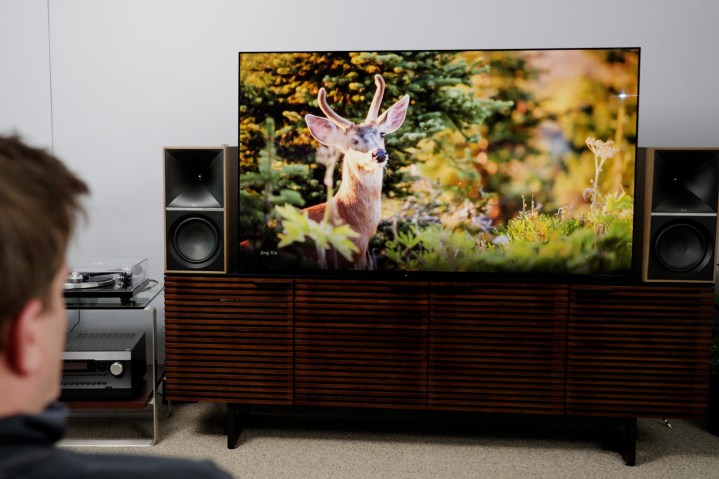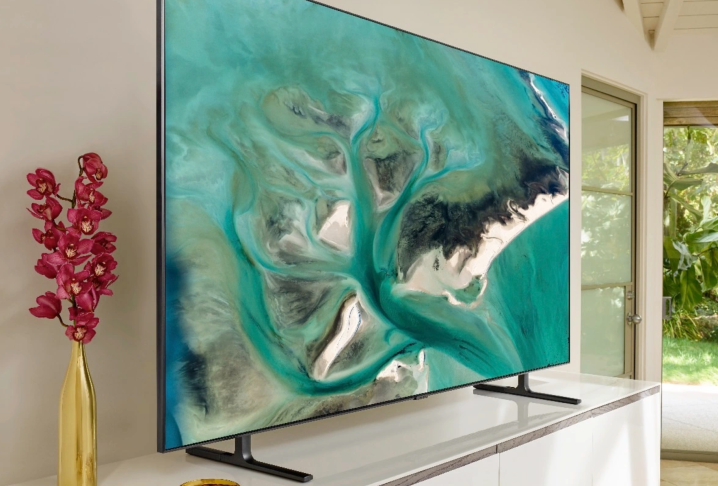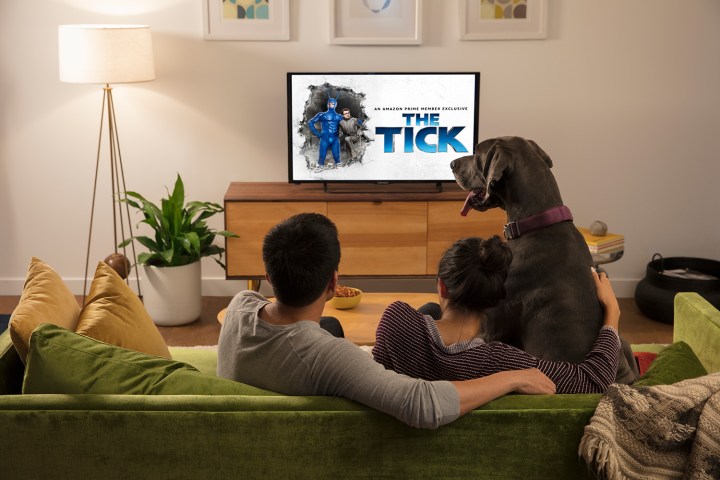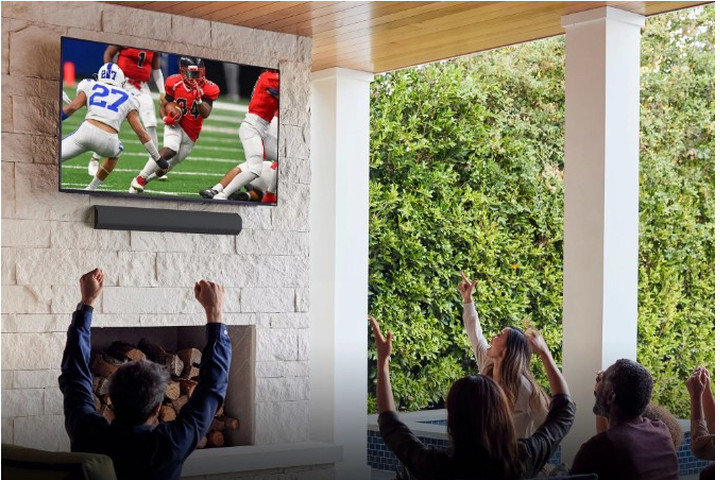
Buying a brand-new TV can be one of the most exciting purchases you’ve ever made, or an all-out nightmare. If you’re leaning toward the latter, we know what it feels like to be bogged down by the many ins and outs of modern TV ownership. You may not even know how big of a TV you should be buying in the first place. But rest assured, you’re not the only person who’s ever had this trouble, and we’re here to help.
Whether this is your first new TV in a long time, or you want to know if you can swap your 65-inch for a 75-inch screen, we’ve put together this guide to teach you everything you need to know about TV sizes, viewing distance, and other big-screen considerations.
How to calculate TV size for your room

Before you decide what kind of TV you’re interested in buying, you’ll want to decide where you want your new television to live in your home. Once you’ve chosen the location, measure the height, width, and depth of that spot (there may be limitations due to the size of an entertainment center or the amount of space on a wall). When shopping around, you can match these dimensions up with the measurements of the whole TV, (not just the screen size) to make sure it will fit. You’ll find that some TVs have footprints that are physically larger than others of the same screen size, so always look at the product dimensions to see whether it will fit into the space available.
Fortunately, most TV manufacturers and consumer tech retailers (including Amazon) will also list these dimensions online and on sales floor product cards. For the former, you usually won’t find dimensions under a product’s top-advertised features and specs, but there’s typically some kind of drop-down or expanded menu called something like “full specs” or “additional info” that has these details. Look here for things like total TV dimensions, how many HDMI ports the TV has, and/or what kind of native refresh rate the display can handle.
If you’re looking for dimensions on a store product tag, try looking at the bottom of the card. Product dimensions are often treated as little footnotes (just like online!) at stores like Best Buy, Walmart and Target, so the height, width, and depth may be twice as small as the other specs on that piece of paper.
TV feet, TV pedestals, and your TV furniture

If you aren’t going to mount your new TV on a wall, you’ll need to consider where the two feet of your new TV are going to be located. In most cases, a TV’s total width (measured from one side of the top or bottom part of the frame to the other) will give you a great ballpark idea as to how long of a shelf your TV furniture should have. But there are rare cases where the TV’s feet can actually extend beyond the left and right sides of the TV. In these cases, you’ll want to either measure the distance between the farthest-extended point of the left foot to the right foot, and use that measurement to determine what kind of TV furniture you should be looking at (or if what you already own will work).
For situations where you can’t wall-mount your TV, and you also can’t see yourself parting ways with a cherished piece of home theater furniture because it’s not wide enough, you can always opt for a universal TV stand. Similar to a standard TV wall mount, VESA-certified arms are screwed into the back of your TV, while a mounting bracket is fixed to the base of the stand. Many universal stands will also tilt up and down and pivot from side to side.
How far away will you be sitting?
Next, think about where you’ll be sitting in relation to where your TV will be mounted or perched. There are TV viewing distance calculators (here’s another one) that recommend a TV screen size based on viewing distance. If you don’t want to bother with an online calculator, here’s a simplified calculation that you can do to work it out yourself (although we do recommend using one of those calculators no matter what):
Measure the distance from your seat to the television in inches and multiply by 0.84. This will give you a rough idea of how large of a TV your space can handle. This method isn’t perfect, of course. For example, if you are sitting eight feet away from the TV, the calculation calls for an 80-inch screen, and that’s just not realistic for most folks. Realistically, you may want to use that rough-idea equation, and then subtract 10 or 15 inches from the result. Generally speaking, the average screen size for most living room TVs is right around 65 inches, and the average size of most living rooms is right around 16 feet by 20 feet. But not every living room is designed the same, and obstacles like fireplaces, interior walls, and load-bearing beams are going to factor into where your TV can be placed, too.
Factoring in field of view and viewing angles

Field of view refers to how much space your TV screen takes up compared to what else your eyes can or will be drawn to in your viewing space. For example, in a movie theater, the field of view is very large because there’s not much else you can see. In a living room, the field of view tends to be on the smaller side, because residential common areas are typically packed to the brim with windows, furniture, lighting fixtures, home decor, and other eye-catching objects and structures. Experts generally recommend a field of view around 30 degrees to 36 degrees. For a 50-inch TV, that would mean sitting around 5.6 feet away. If you have limited space, you can always use field of view in reverse to pick the size of your TV based on where people will be sitting.
Don’t confuse field of view with viewing angle though (or how easy it is to see the TV when sitting off-center from the screen). A TV’s viewing angle depends on the display type, with OLED TVs generally having the best viewing angles you can find on modern sets. But overall screen size is helpful, too. After all, the bigger the display, the easier it should be to see it from multiple vantages. However, ambient lighting and how it contributes to screen glare is another variable you’ll want to consider when thinking about your TV’s viewing angle.
Size versus quality

If you’re trying to maximize screen real estate on a tight budget, you’re going to have to sacrifice some picture quality for a bigger screen (in most cases). As such, we recommend (as per our comprehensive TV buying guide) striking a balance between screen size and quality. So instead of going for that massive 85-inch QLED from an up-and-coming brand that’s on the shelves for just $500, consider opting for the smaller, 55-inch big-name model next to it for $550. Chances are the latter uses far better picture processing and lighting technologies — and brands like Samsung and LG are tried-and-true TV companies that deliver great sets year after year.
You’ll also want to keep in mind the types of content you’ll be viewing. If you’re a Blu-ray enthusiast or 4K streaming connoisseur, your 4K or 8K TV is going to have more picture info (and thus greater detail) to deliver than someone watching mid-90s Crash Bandicoot speed-runs on YouTube. There’s nothing wrong with the latter, but the fact remains that low-polygon marsupials just aren’t as pixel-packed as our favorite blue heroes from 2022’s Avatar: The Way of Water.
Leverage the power of your wall mount

If you’re going to mount your TV, you’ll have a few different mount styles to choose from. Low-profile and tilting mounts will keep your TV closest to the wall. There’s also full motion arms, which are usually the most expensive models you can buy, but for good reason. These mounts tilt up and down, but they can also swivel from left to right, and extend out toward the viewer. So consider this: Even if you’re only mounting a 55-inch TV, if you’re using a full motion wall mount, you’ll literally be able to pull the screen closer to your eyeballs.
As you can guess, full motion mounts are sold by numerous companies, but we’ve got a few recommendations and installation tips for you to peruse.
What is the most popular TV size?
Generally speaking, we’d say most folks end up with a 65-inch TV in their living room, with other common sizes including 55, 60, and 75-inch sets. But all homes are different, and while a large-sized screen may work for Household A, it may totally swallow the living space in Household B.
Measure twice, and buy once, friends!
How far away should you sit from a 65-inch TV?
For those of us rocking a 65-inch QLED, OLED, or traditional LED-LCD, you’ll get the best viewing experience by sitting between six to seven feet away from your TV.




